Genesis GV70 3.5TT Long-Term Review
As the Genesis brand fights for a foothold in the luxury market, only the GV70 has won over the hearts and minds of Aussie buyers. We’re going to find out why
Spun off from Hyundai’s ‘Genesis’ limousine into a standalone nameplate in 2015 before making its local debut in 2019 with the G70 sedan, the budding luxury brand from Korea should be hitting its stride right now, but when will Genesis have its revelation?
While it passed the one million global sales milestone in 2023, fast forward to 2025 and things are less rosy here in Australia, with just 1178 registrations recorded as of September. That’s an increase of 8.9 percent, but it’s also a drop in the ocean compared to segment leaders BMW (20,301) and Mercedes-Benz (17,150), along with Audi (11,001) and Lexus (10,867).

To be fair, luxury segments are historically ruthlessly difficult to break into, with badge loyalty not just an obstacle to overcome, but a tool to harness long-term success. The Australian market has arguably never been so congested and competitive, either, with newcomer Zeekr already clocking up 730 local registrations after barely a year since its introduction.
Perhaps more concerning is the fact that only one model is doing all the legwork at Genesis: the GV70 midsize SUV. Everything else, including the fully-electric GV60 midsize SUV, the recently updated GV80 large SUV and the G70 and G80 sedans, have all declined in sales.
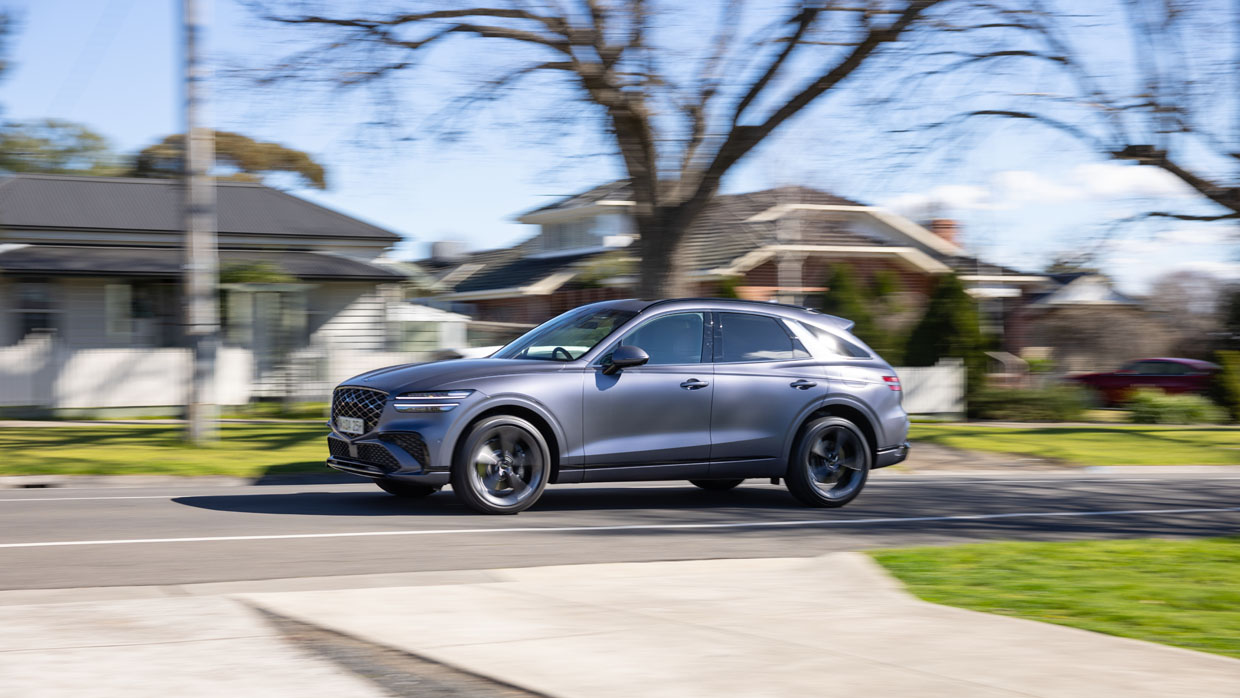
But the GV70 is clearly running its own race, with sales up 56 percent so far this year. Its owners aren’t fools either; this midsizer has generally held up well under our previous assessments – but the sales pitch hasn’t been without its drawbacks.
The GV70 package is said to have improved with the facelift applied at the end of last year and yet pricing still remains enticing compared to rivals such as the BMW X3, Mercedes-Benz GLC, Audi Q5, Volvo XC60 and many more.
It’s for that reason, among others we shall now discuss, that we’ve decided to take one on for a gruelling six-month review.
Month 1: The Genesis of our test
- Odometre start: 6422km
- Kilometres this month: 1067
- Fuel consumption: 12L/100km
- Costs this month: $283.69 (fuel)
What is it?
The GV70 midsize SUV first launched locally in 2021. This is the first and only generation so far, though it received a mid-life facelift in Australia at the back end of 2024.
It’s an important vehicle for the Genesis brand as it competes in a highly lucrative segment, against big-hitters like the BMW X3 and Mercedes-Benz GLC.

How much is it?
The GV70 starts at $78,700 for the entry-level variant equipped with a 2.5-litre turbocharged four-cylinder engine in ‘Advance’ guise. Buyers can opt for the better-equipped ‘Signature’ for $87,700 or Signature Sport for $89,700.
We’ve opted for a GV70 in Signature Sport guise armed with the V6. It serves as a well-equipped grand touring vehicle with a list price of $100,200. Expensive, but significantly cheaper than high-performance rivals such as the Audi SQ5 ($125,900), BMW X3 M50 ($129,600) or Mercedes-AMG GLC 43 ($136,900).
On the road, our GV70 costs $111,840 when equipped with Makalu Grey Matte paint. It’s the only option on our car, and it costs an extra $2000.
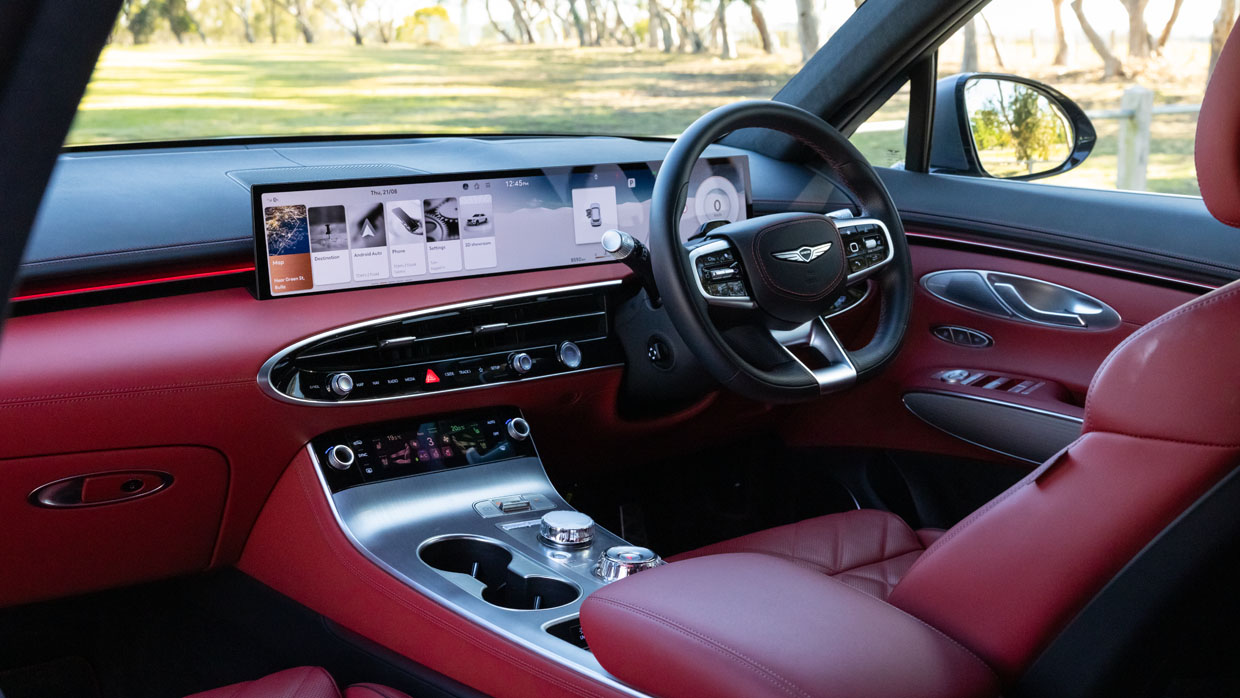
What’s the spec of our car?
Offer a lot, ask for a little. It’s the playbook of new car brands around the world, and while our circa-$110K GV70 is a very expensive vehicle, it’s certainly very well equipped with the following feature highlights:
- 21-inch alloy wheels
- Power tailgate
- 27-inch touchscreen
- Head-up display
- 16-speaker Bang and Olufsen sound system
- 18-way power adjustable, heated and cooled front seats
- Centre console with UV-C sterilisation
- Heated rear seats
- Three-zone climate control
- Second row pull-up sunshades
- Nappa leather upholstery
- Heated sports steering wheel
- Air Aroma Diffuser
- Blind spot view monitor
- 360-degree camera
- Phone app connectivity

The step up to our ‘Signature Sport’ is primarily a difference of styling and in our eyes, one worth indulging in, with racier 21-inch alloy wheels, a more handsome front-end, dual exhaust tips and a smattering of sporty touches in the interior – such as the alloy finish for the pedals.
It’s not all show without go, however, as the Signature Sport uniquely comes with a ‘Sport+’ model that allows the brave to turn off traction and stability control.
How long is it sticking around for?
The plan is to hang onto our GV70 for six months. In that time, we plan to put 10,000 extra kilometres on the odometer, which has already endured 6422km of ‘gentle driving’ from other motoring journalists prior to our custodianship.
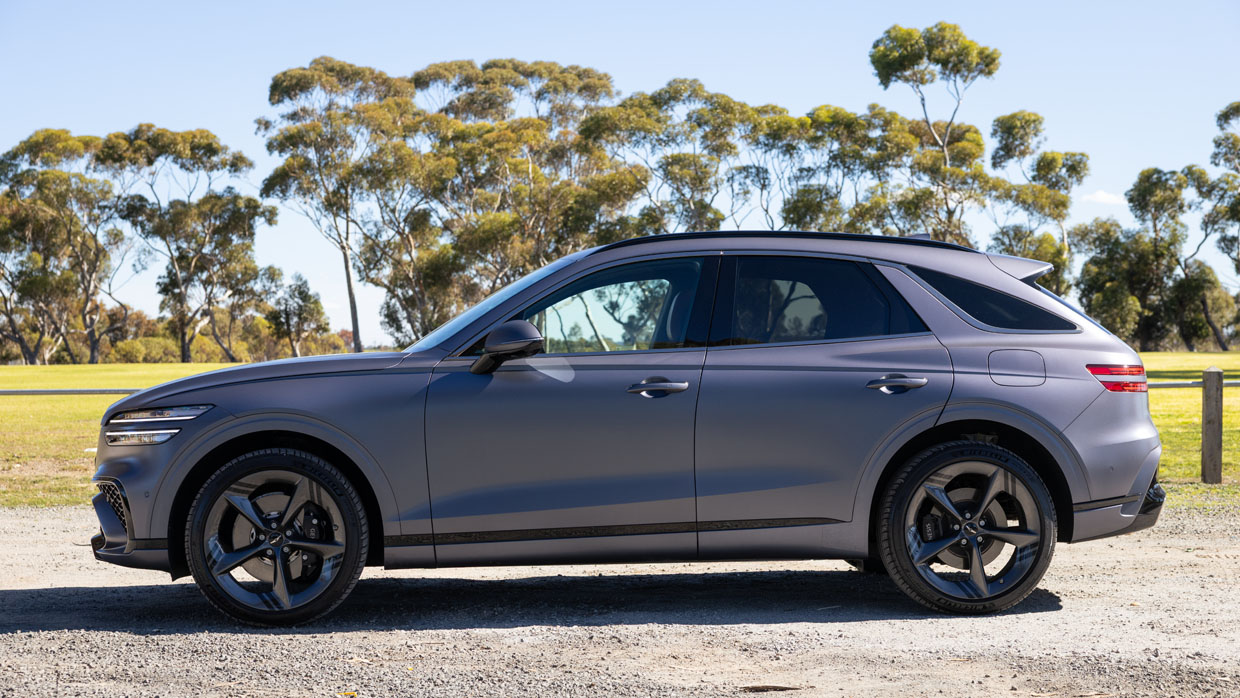
What are we going to do with it?
Practicality is a must for our GV70, which will serve primarily as the everyday commute vehicle for my family of four, including two kids under three.
That means baby seats (forward- and reverse-facing), a pram in the boot, sticky fingers and daily trips to and from their local daycare centre. Plus, whatever else family life throws at us, we never really know….
We’ll also be doing some roadtrips between Melbourne, Sydney and possibly Adelaide to add some kilometres to the odometer and assess its grand touring abilities.
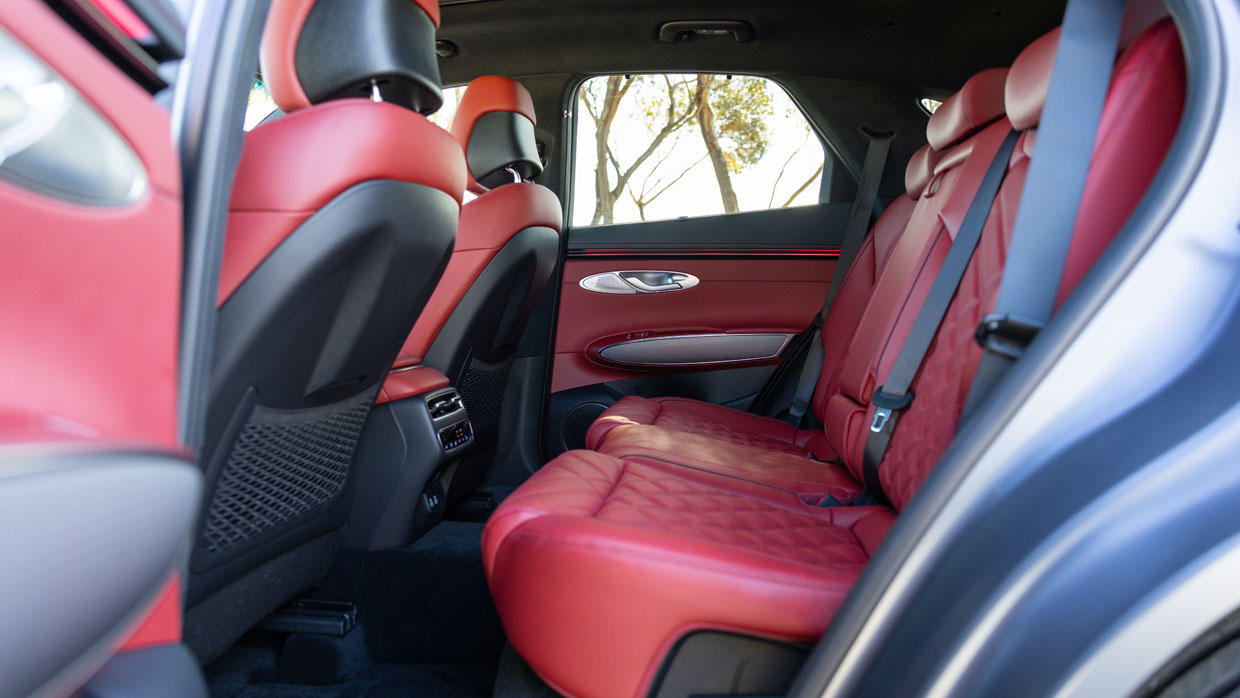
Naturally, there will also be a comparison test against its rivals to discover where it sits in the luxury midsize SUV pecking order.
To make sure we cover off the entire range, we’ll jump into cheaper variants powered by the 2.5L petrol engine and the fully electric version, which is named – would you believe it – the ‘Genesis Electrified GV70’. Bonuses all-round for the marketing team who came up with that…
Initial performance
After nine months of living with utes, first the Mitsubishi Triton and then the Volkswagen Amarok, it was time to shake things up with an altogether different proposition.
In place of Roman-era leaf-spring suspension, our GV70 has adaptive dampers paired with a camera that scans the road ahead to detect imperfections and react accordingly.
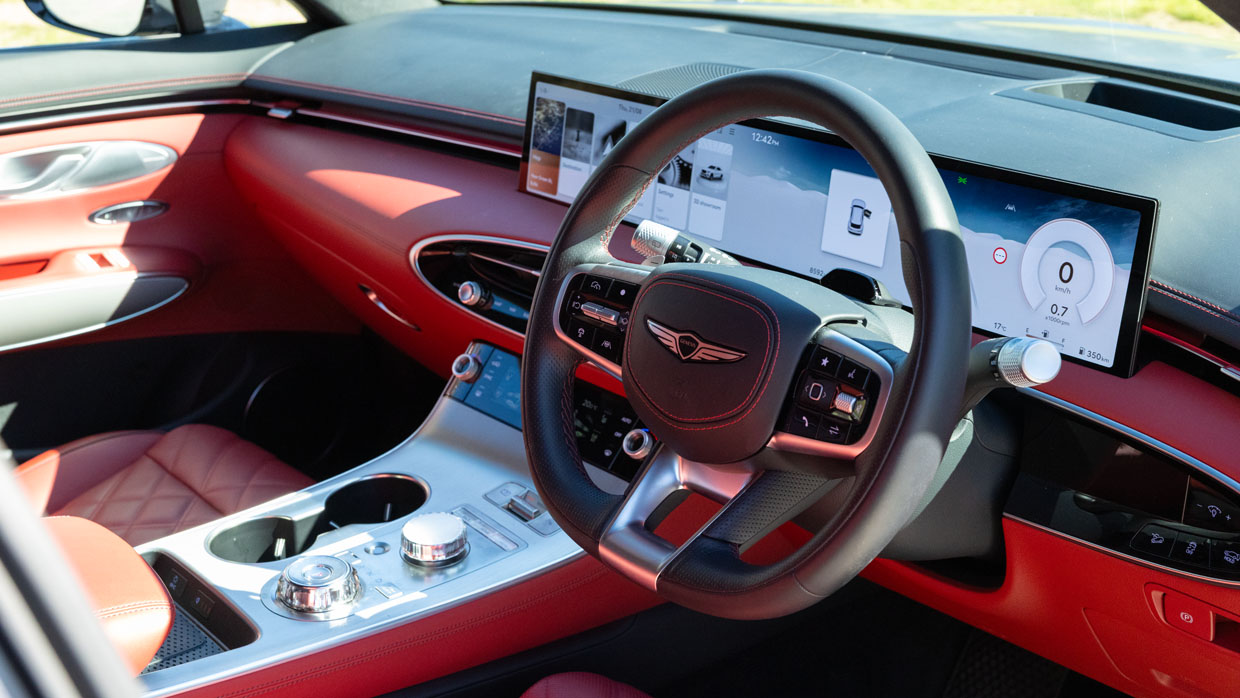
In place of 9.0- or 12.0-inch touchscreens, we have a whopping 27.0-inch widescreen that sweeps across the dash – itself clad in rather lovely red leather.
In place of diesel-clatter, we have a twin-turbo V6 petrol engine plying 279kW and 530Nm of torque to the road in a polite, yet savage manner.
Point being: it’s time to pop in my monocle, pretend I’ve jumped up a few tax brackets and settle into the luxury language for the next six months and 10,000km.

This sort of chopping-and-changing is a common part of motoring journalism but living with a luxury vehicle for half a year is quite rare, and given the miserable reputation some high-end vehicles carry for long-term reliability, I was a bit concerned…
‘Owning’ a vehicle with infamously sensitive matte paint has renewed my hatred of birds and while the clever suspension system might be scanning the road ahead, one look at the potholes in my area and the only message it will be sending back to the dampers is ‘brace for impact’.
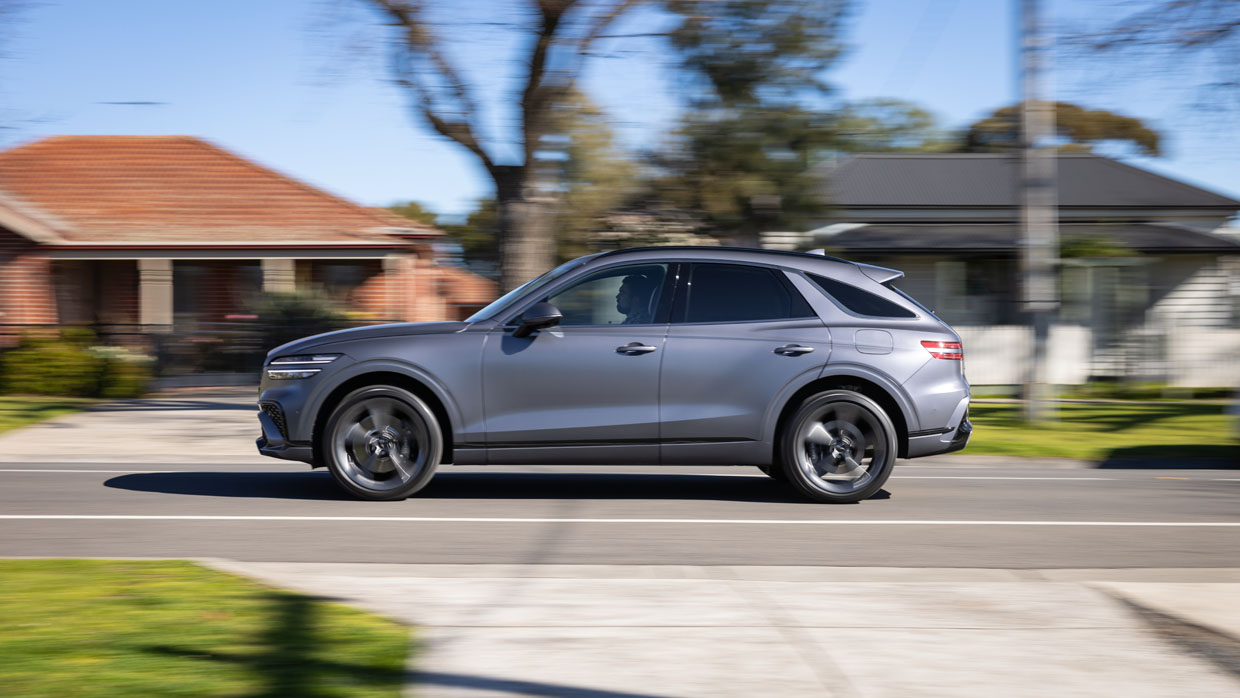
Those 21-inch wheels wrapped in 255/40 Michelin Pilot Sport4 SUV tyres are in for a fight, but to their credit, my initial experience has been quite positive, and I was both delighted and surprised to discover a space wheel under the boot floor of our GV70 if anything goes awry.
While some might snicker and call it the ‘Kia Stinger’ engine, the 279kW/530Nm 3.5-litre twin-turbo V6 engine is a mighty thing to drive every day, and the GV70 very much conveys a sense of budget Porsche Macan vibes with the way it drives. That’s no criticism, that’s praise to the highest degree.
It comes at a cost, however, as the big V6 loves a drink. So far, we’ve recorded consumption of around 12L/100km using 98 Ron fuel exclusively, driven primarily in urban areas.
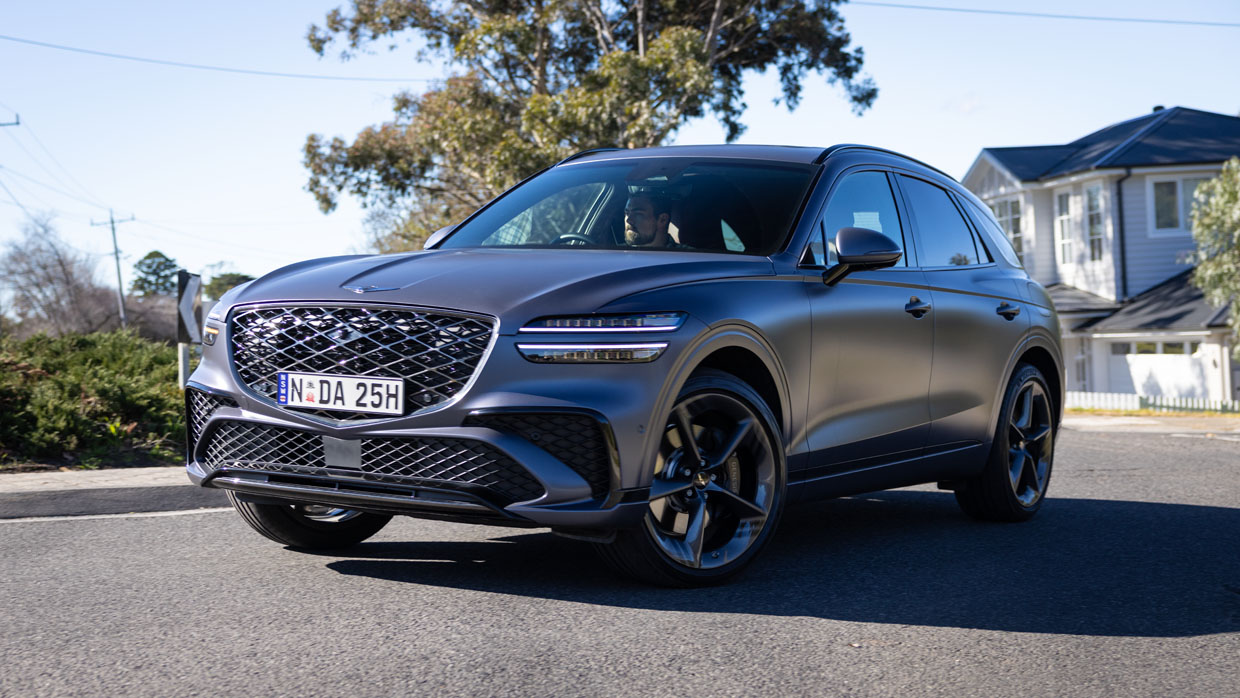
We plan on doing more highway miles to provide a more accurate figure across a range of conditions, but even the 11.3L/100km rating is significantly higher than rivals such as the BMW X3 M50 (8.2L/100km) and Audi SQ5 (7.6L/100km), which offer similar performance.
We’ll keep an eye on fuel consumption, but it’s otherwise, so far, so good for the GV70, but time will always tell and we have a lot of time….
Mazda CX-60 G25 2026 review
3 days ago

In an attempt to offers buyers more choice, Mazda has introduced a fourth CX-60 powertrain – a 2.5-litre four-cylinder with rear-wheel drive, saving $6000
Good points
- Peppier than expected when driven hard
- $6K cheaper than the six
- Pleasant at glacial pace
- Well-balanced handling
- Eight-speed automatic’s extra ratios
Needs work
- Over-firm ride quality
- Lazy drivetrain calibration in Normal mode
- No more economical than the turbocharged six
- Struggles carrying a load
- Pure and Evolve should be a single specification
Just over three years after the ‘premium’ CX-60 arrived in Mazda’s Australian showrooms, followed by two rounds of suspension revisions – the most recent being a comprehensive retune in April 2025 – a new four-cylinder base engine has debuted in the CX-60, taking its powertrain choices to four.
It’s a familiar engine – the 2.5-litre ‘SkyActiv-G’ naturally aspirated four-cylinder that debuted in the third-generation Mazda 6 in late-2012 and original CX-5 in 2013, which has since powered over 400,000 Mazda vehicles in Australia. It produces 138kW and 250Nm.
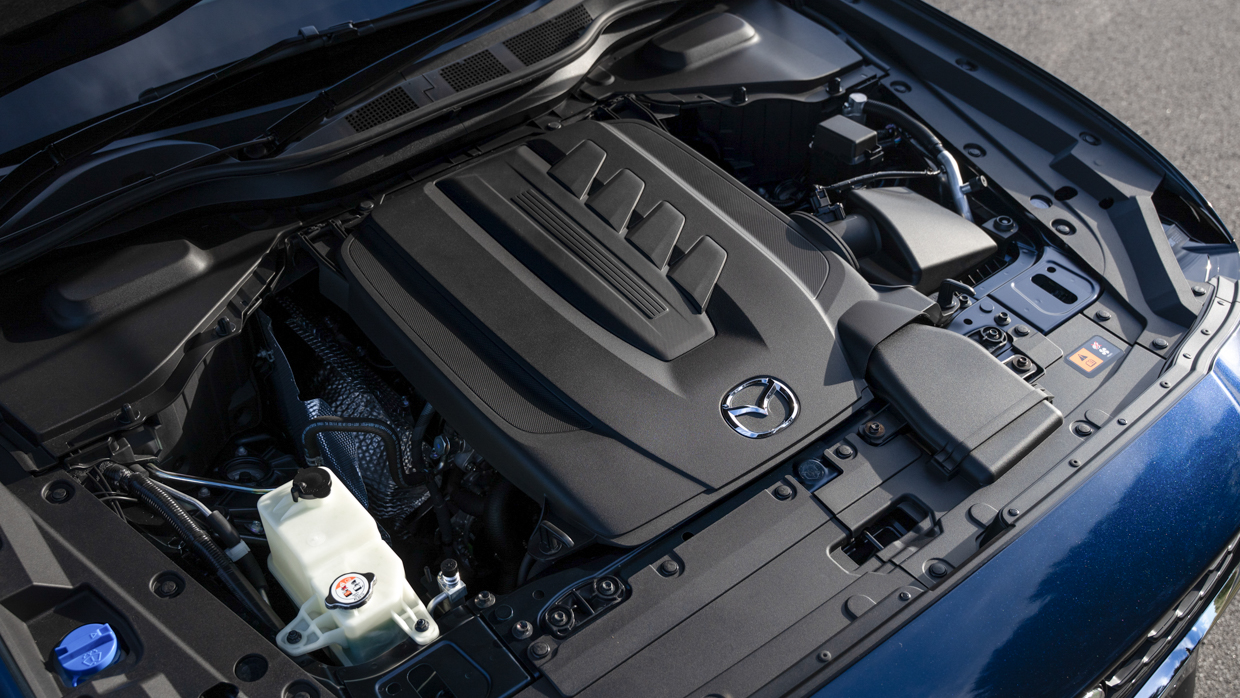
But this is the first time it’s been turned north-south in a longitudinal configuration, exclusively driving the rear wheels in this ‘affordable’ new entry-level CX-60.
For a blanket $6000 saving over the turbo-petrol G40e six-cylinder CX-60 variants, the new G25 four-cylinder is offered in three identical trim levels to the sixes – Pure ($44,240), Evolve ($49,240) and Touring ($52,240), with a $47,990 drive-away offer on the G25 Pure.
Given the CX-60’s ‘premium medium’ launch positioning, as well as the existence of Mazda’s big-selling CX-5 medium SUV ($36,740 to $55,650) – which will be replaced by an all-new model in the second half of 2026 – you might be questioning why Mazda Australia felt the need to introduce a four-cylinder CX-60.

The answer is greater choice. Spec for spec, the CX-60 G25 Touring (the ideal trim grade, though more of that shortly) is $9640 more expensive than the CX-5 G25 Touring, for which you get a slightly larger, much newer design with a classier interior, rear-wheel drive (instead of front-drive) and an eight-speed automatic transmission (instead of a six-speed).
Mazda expects the four-cylinder version to account for 34 percent of total CX-60 sales going forward (currently around 5500 units annually), with the most popular trim level being the GT (making up 31 percent, though only available in six-cylinder versions and the plug-in hybrid), followed by the new base Pure grade (22 percent).
As for which is the best variant to buy, the Touring makes the most sense with its perforated leather trim and heated electric front seats, plus wireless phone charging, power tailgate, front cross-traffic alert, 360-degree camera and 12.3-inch TFT driver’s display it inherits from the cheaper Evolve.


Unfortunately, the Evolve features sticky vinyl ‘Maztex’ upholstery while the entry-level Pure (which gets pleasant all-cloth upholstery) replaces the dashboard’s soft-touch finishes and the door’s stitched-upholstery wrapping with rock-hard plastic – meaning an Evolve with the Pure’s seat upholstery would be far more preferable…but not possible.
As for the topic at hand, what about the CX-60’s new four-cylinder powertrain? Does it suit the CX-60 as a starter engine or is it a false economy, so to speak?
Firstly, it saves $6000, so if you’re a retiree who can make that amount go a long way and prefer the CX-60’s size over a CX-5, then there’s logic to this new base version. It’s also rear-wheel drive, so it may make further sense if you don’t need an AWD vehicle.
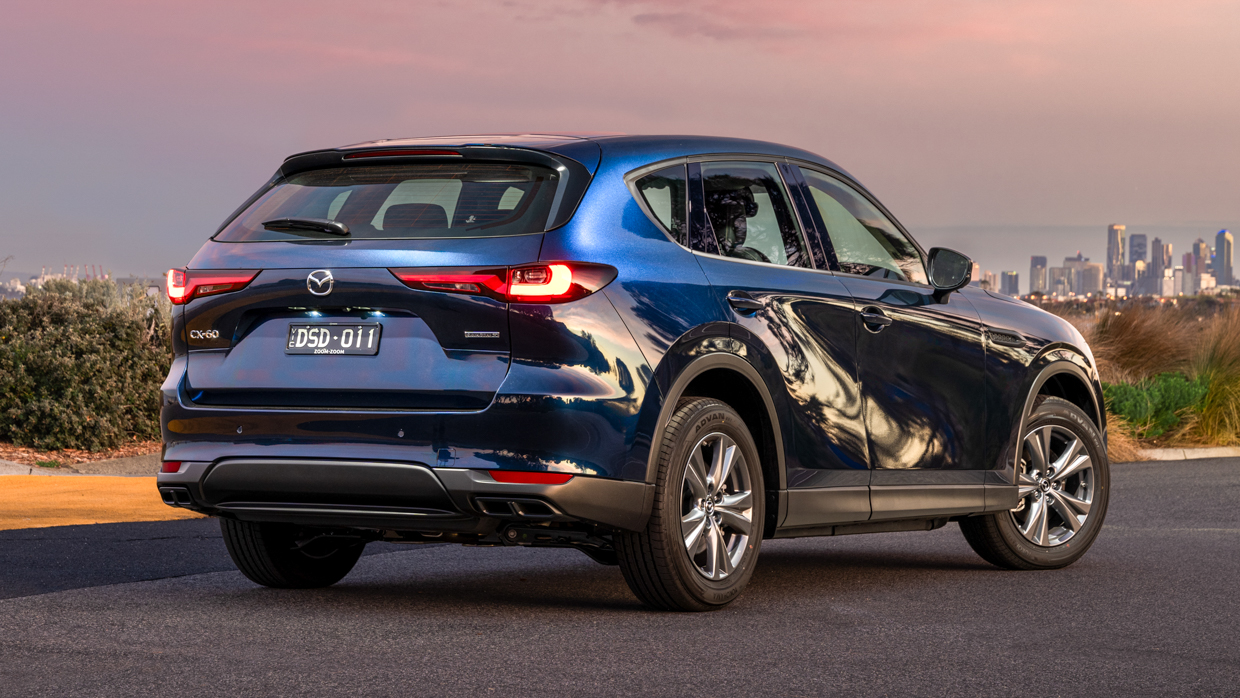
But there is no fuel economy gain in choosing the four-pot CX-60 G25. Its official combined fuel consumption of 7.5L/100km is slightly thirstier than the six-cylinder turbo-petrol G40e (at 7.4L/100km, with both tuned for 91-octane regular unleaded).
And while the four-cylinder CX-60 weighs around 150kg less than the six-cylinder AWD, it forgoes a massive 71kW of power and 200Nm of torque in its cost-saving quest for a sharp entry price.
That level of output reduction has a sizeable impact on the CX-60’s performance and driveability. The power-to-weight ratio of a base four-cylinder CX-60 Pure is just under 75kW/tonne whereas its six-cylinder equivalent is 104kW/tonne (and a front-drive CX-5 Touring is 87kW/tonne) – making the six-pack version 39 percent better off on paper.
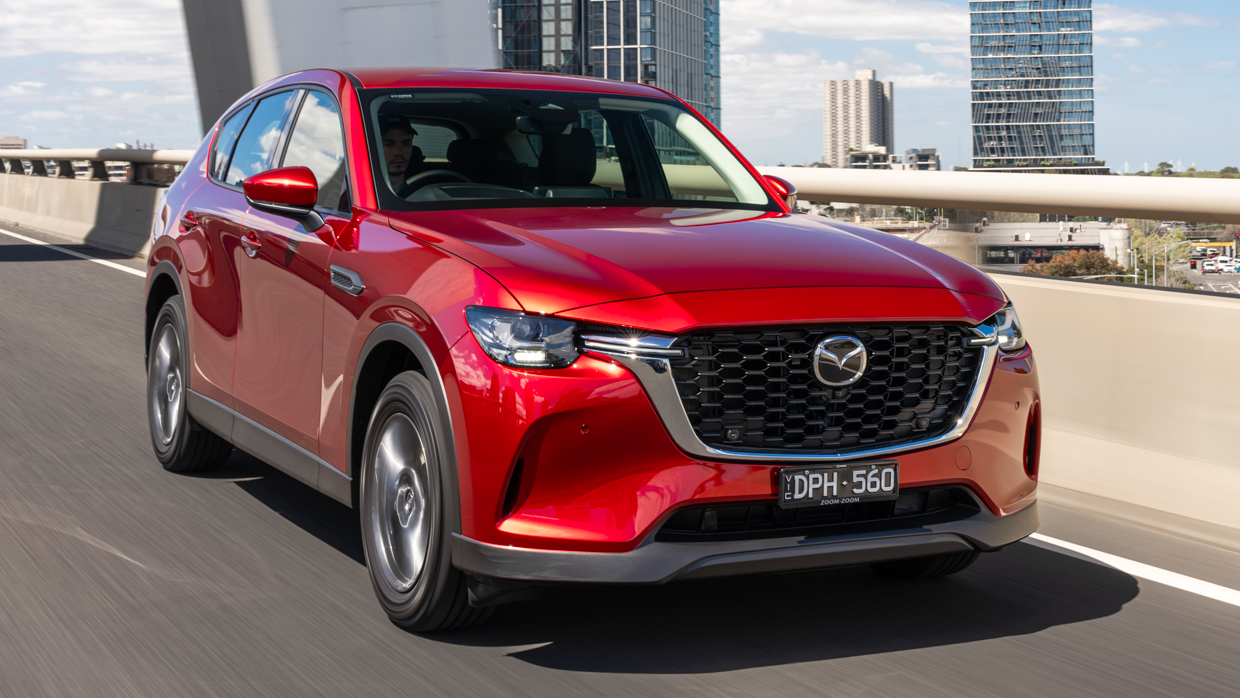
On the road the difference feels similarly dramatic, though the eight-speed auto four-cylinder is smooth and unobtrusive in modest day-to-day running. Make minimal demands and it achieves all anyone could ever expect. But when challenged, it lacks the torquey, wafty effortless of the turbo-six and is let down by its calibration.
Driven in Normal mode (the default at every restart), the four-pot CX-60 is tuned purely for economy – meaning a dogged reluctance to downshift on hills, to the detriment of maintaining speed. And once the 2.5L SUV has lost so much pace that it’s forced to shift down, it needs to mine its ratio set to regain momentum – surely at the expense of real-world fuel efficiency.
Flick the ‘MI-Drive’ toggle to Sport mode and things are dramatically improved. Throttle response is much keener, gear selection is far more immediate and the four-pot CX-60 finally feels like it deploys everything it has available…but few, if any, four-pot CX-60 buyers are going to do that.
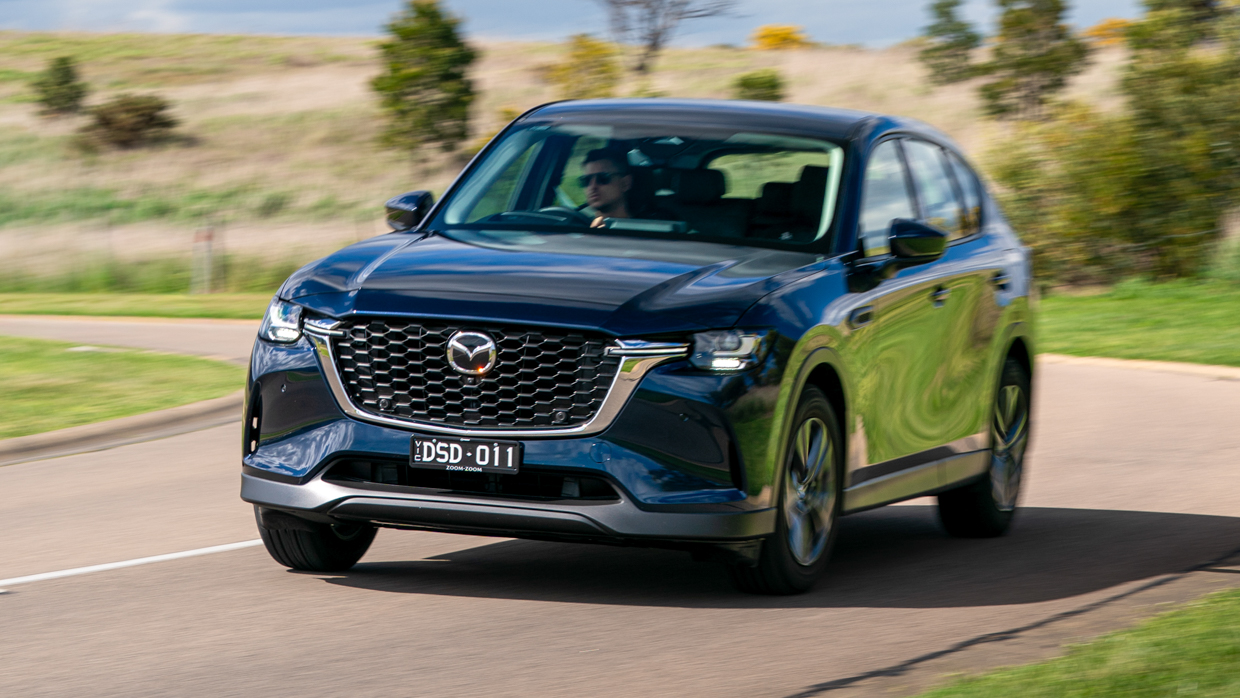
And even then, with your right foot mashed, you’re looking at 0-100km/h times of 10 to 11 seconds here, not the high-sixes of the turbo six.
The four-cylinder doesn’t sound particularly inspiring when being driven hard either – its rather hollow induction note ceding aural pleasure to the lusty, thrusty boosted six. And it doesn’t blend as well with the CX-60’s extensively retuned chassis – not compared to the firm but focused flavour of the updated six-pack.
Mazda has revised the spring and damper rates to enhance ride comfort and roadholding, while also lowering the mounting point of the front knuckles to “enhance understeer control” and removing the rear anti-roll bar in order to reduce oversteer.

There’s also shorter rear bump stops for greater suspension travel, different rear axle bushes to enhance control, revised stability-control software, less steering vibration and improved steering feel. Yet somehow the four-cylinder’s firmness doesn’t feel as finessed or as high-quality in its behaviour as the six-cylinder’s suspension.
Ultimately, it’s too firm for an SUV with such limited performance ambitions, and the same goes for the steering tune, which is quite heavy compared to most power-steering systems and, when combined with a busy 3.3 turns lock-to-lock, makes 90-degree urban turns at 40-60km/h speeds more of a chore than it should be in a car most likely to be bought by retirees.
That’s the demographic that best suits the CX-60 four-cylinder – older people not in a hurry, who won’t miss the six-cylinder’s grunt, but will undoubtedly appreciate the $6000 saving, as well as the CX-60’s pleasing seat comfort, easy control layout, impressive build quality and tangible standard equipment at Touring level.
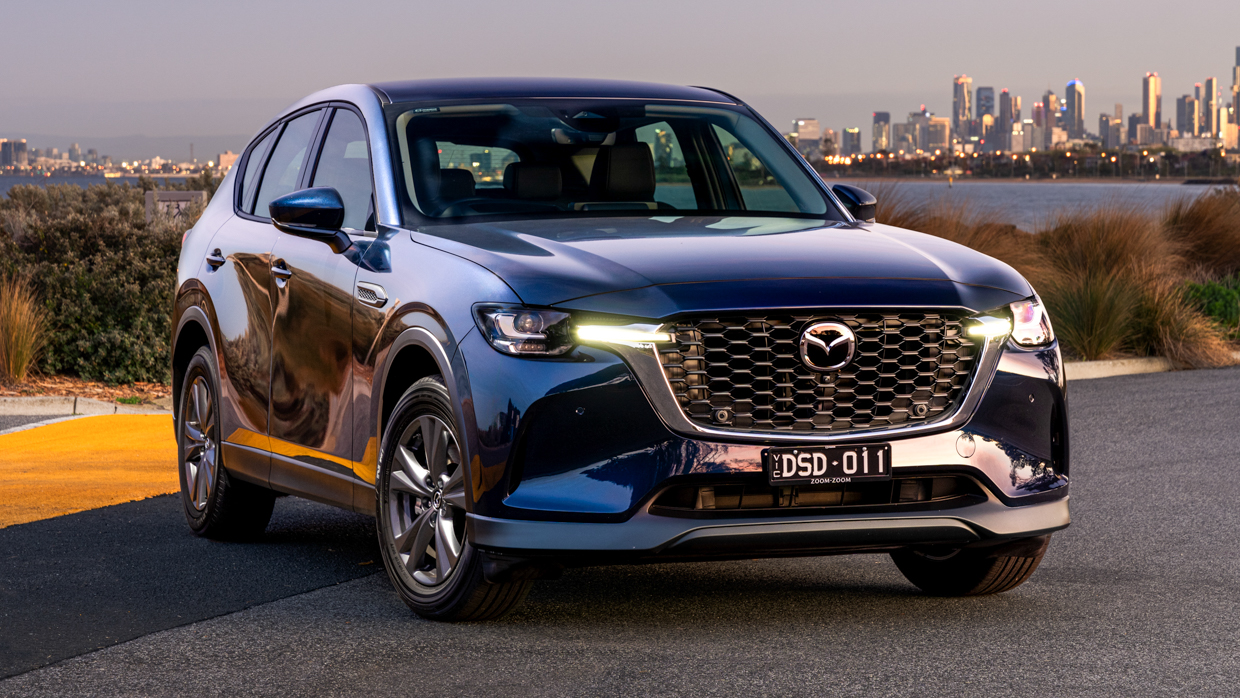
But in our opinion, the turbo-petrol six-cylinder is worth every extra cent. It’s more refined, far more effortless to drive and much easier to spend time in, yet rides with greater finesse and offers the roadholding advantages of AWD – all without any detriment to its fuel consumption.
If you want a four-cylinder Mazda SUV, we’d suggest investigating the current 2.5-litre CX-5 (turbo or non-turbo) as it approaches its run-out phase, or the next-generation CX-5 when it arrives in the second half of 2026.
Mazda BT-50 2.2L 2026 review: First Australian drive
5 days ago

Is the new 2.2L engine a better proposition than the phased-out 1.9L unit, or is the proven 3.0L still the only one to buy?
Good points
- Steers and handles well
- New transmission spec is good to see
- Comfy Mazda-spec interior
Needs work
- 2.2L lacks torque
- Price is still high
- Diesel chatter at take-off
Mazda wants a bite of the lucrative tradie and fleet market pie. That’s why we were presented with a hard hat and high vis vest at the 2026 BT-50 2.2-litre diesel launch, to live the tradie life for a day. I politely declined.
The Hiroshima brand has put the 1.9L turbo-diesel engine out to pasture, replacing it with this new 2.2-litre unit that produces an on-paper uninspiring 400Nm and 120kW. Well, replace isn’t quite the right word, as the 2.2 is a stroked and bored-out version of the 1.9L.
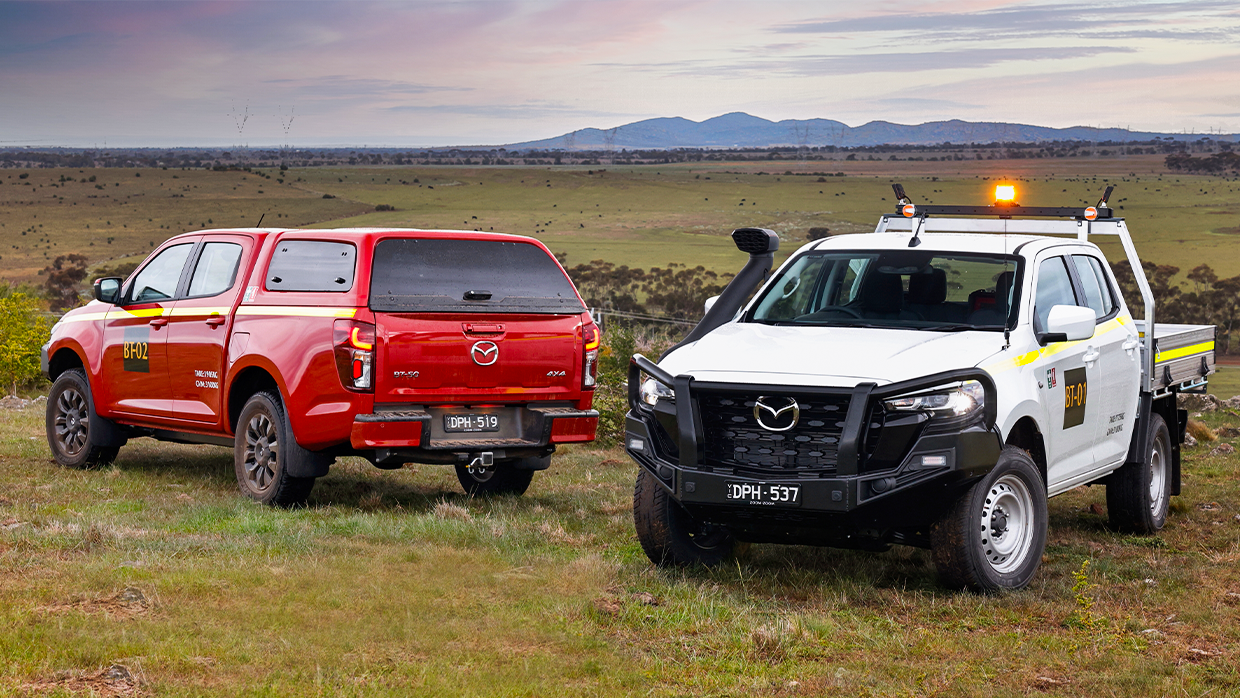
Claimed fuel economy now hovers around the 6.3L/100km range, which is approximately 1.0L/100km better than the 3.0L engine. Carbon dioxide (CO2) emissions are listed at 167g-188g per kilometre for the 2.2L and 185g-204g for the big three-litre unit.
Even a small gain could be big news for under incoming New Vehicle Efficiency Standards (NVES) — the headline targets are 180g/km for 2026 which then drops sharply to 150g/km in 2027.
Stray above these targets and importers will need to pay fines (in other words, pass the added costs onto consumers), which will add up to hefty numbers for those without EVs and PHEVs in their stables.

The new 2.2L is also a little bit cheaper for buyers than the 3.0L 4JJ3-powered Mazda BT-50, saving about $2500 depending on grade. Which could be an appealing option for fleet markets more so than private buyers. And why is that?
Well, think about the numbers: if a fleet is buying 100 units, and they can pocket $2500 on each one, that’s a saving of $250,000. A nice little boost for the office Christmas party fund.
Mazda also has a new, fleet-focused 2.5-litre petrol CX-60 making a double-whammy for the Japanese brand, with a premium-feeling work ute and medium SUV bundle for fleet customers.

So that’s the first reason why the Mazda BT-50 and Isuzu D-Max (on which it is based) offer a lower performance model. With that slightly lower price tag and reduced emissions, in an effort to entice trades, fleet and mine buyers to open their wallets and buy in bulk.
The other reason is that the 3.0L 4JJ3 motor, which is highly regarded for being strong as an ox and rather de-tuned from the factory, is getting old, and is only really big in the Australian market.
With strict emissions laws looming, it’ll be hard to keep selling it — another option was required.
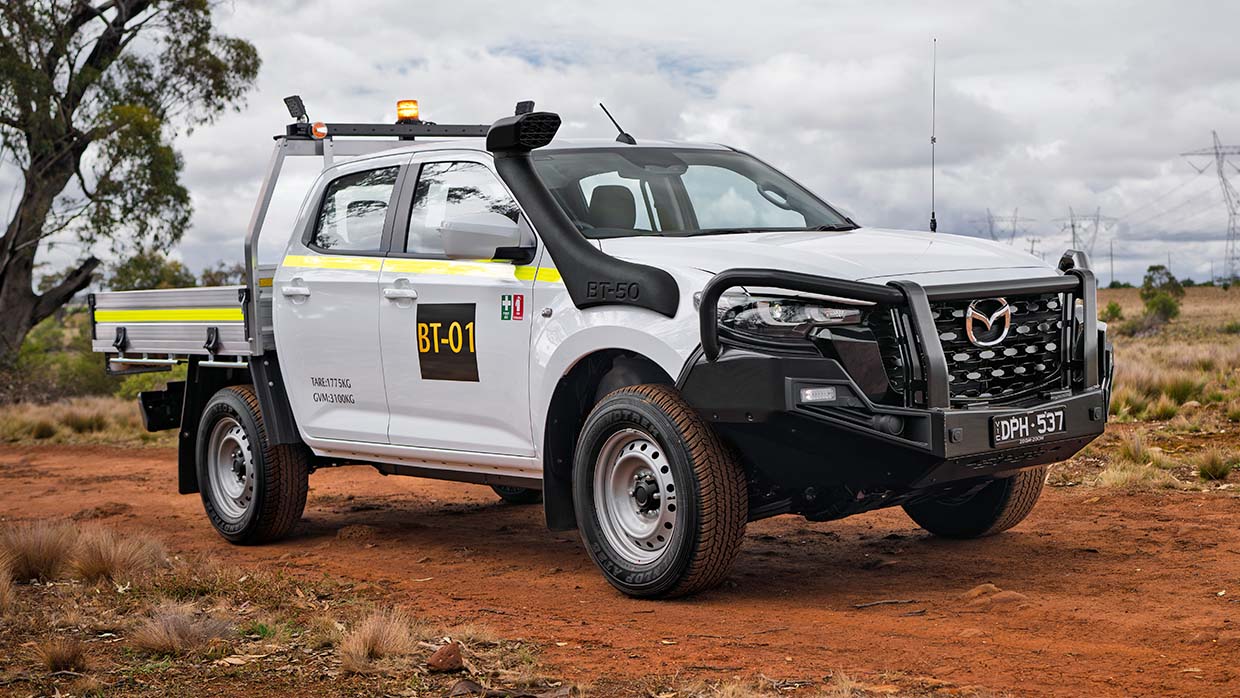
Sure, the performance of the 1.9L was adequate when cruising on a highway, and it sipped diesel, but even a bicycle going downhill accelerated faster. Which is why towing capacity was listed at 3000kg rather than 3500kg, the industry standard. That 1.9L just didn’t have the grunt to pull that much weight.
I have no doubts the 1.9L is a strong and reliable unit, one look at the Thailand 4×4 scene, where this vehicle is manufactured, shows all sorts of power upgrades happening.
But it hasn’t struck a chord with the Australian market, who has been sold the spirit of the 4J truck motor since day one. A victim of Isuzu’s own marketing success, if you will.

So how does the 2025 Mazda BT-50, with the 2.2L turbo-diesel power-plant mated to a new eight-speed transmission (up from the previous AISIN six-speed) drive? Not great, to be honest. But that’s the point. It’s not supposed to be inspiring, it is a tool for work and getting the job done.
The motor lacks torque, it wouldn’t spin a tyre when accelerating hard from a start. Brief testing saw 0-100 times of just under 12 seconds, to paint a picture.
It’s also loud on take-off, with heaps of clatter. This is a surprise, considering how much criticism Isuzu and Mazda received for the amount of noise the 3.0L produces. There’s also a fair chunk of turbo-lag while moving off the line.
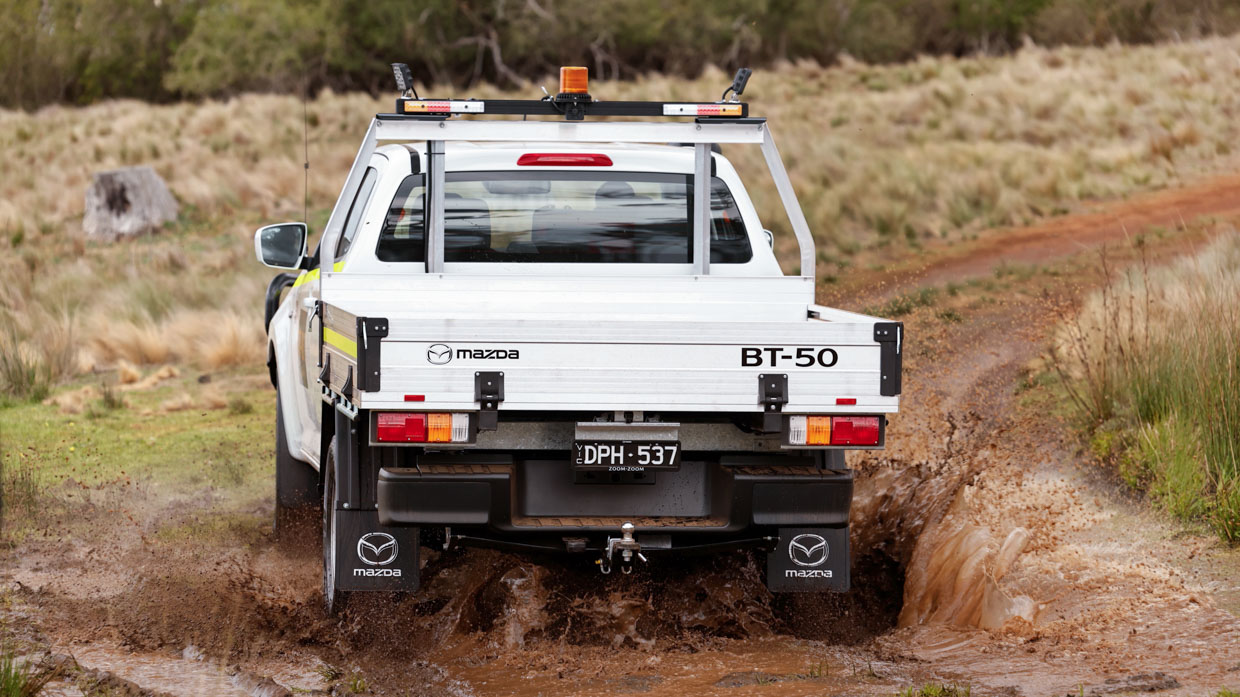
It would be safe to assume this engine is running a high amount of turbo boost pressure to get it moving — hence the lag while the turbo does its best to get spinning.
This lack of torque shows there is improvement required regarding the transmission tune. It almost feels like the transmission is asking permission from the engine to change gears. Resulting in recalcitrant gear changes, with flaring between shifts. Please sir, can I have some more torque?
Unladen suspension feel is naturally on the firmer side, not as stiff as the current generation Toyota Hilux, but still on the jiggly side. Steering feel though, is excellent. Full points in that department, with a decent turning circle also experienced.
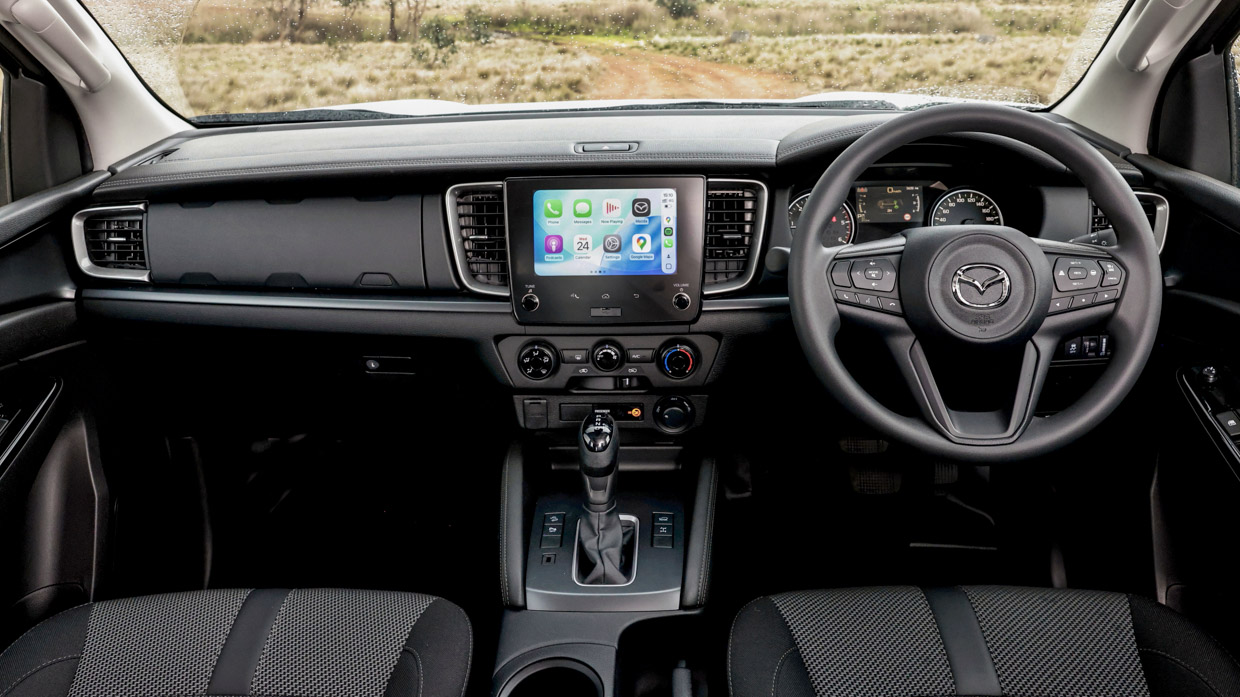
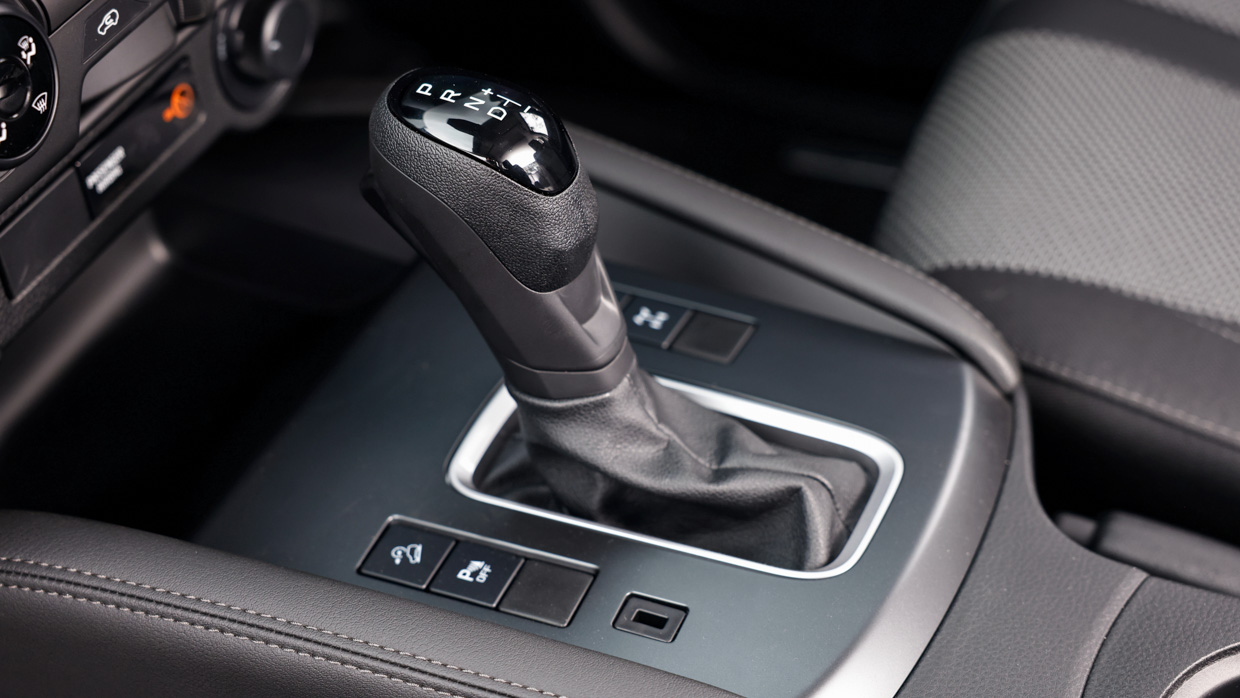
The vehicle felt planted at all times, even without the option of full-time 4×4. Which would be a useful addition to the vehicle, when you think about the modern crop of dual-cabs such as the Kia Tasman and Mitsubishi Triton, which are mostly offering a full-time 4×4 option for more grip on wet slippery roads.
Cabin appointments feel robust, and well thought out. It’s a nice interior to be in, especially for a ute. I particularly like the seat comfort, with the right amount of bolstering, in the right places. This is a ute you could happily spend all day in and not feel too sore or tired by knock-off time.
There are three interior offerings depending on model grade selected: GT spec sees black leather seat trim; SP grade sees a rather unique (again, for a ute) Terracotta ‘Maztex’ synthetic suede trim. Black cloth is standard on lower specs.

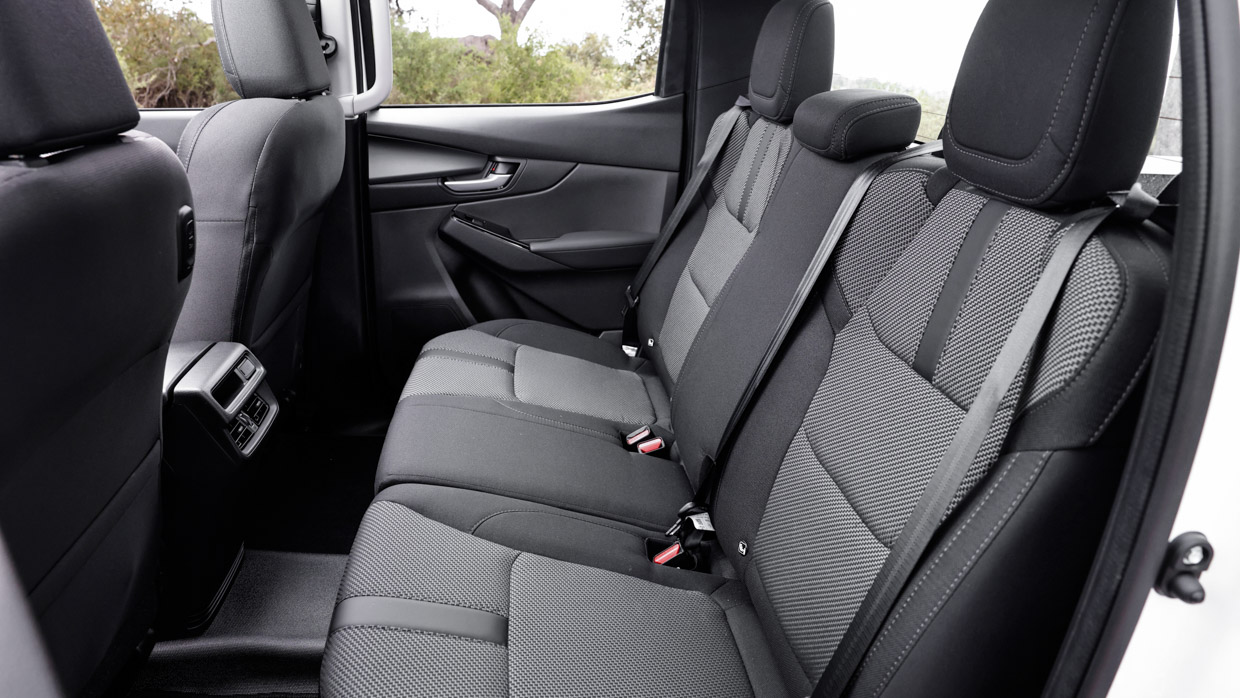
Brake feel, however, is on the spongy side, with a fair amount of pedal travel required for take up. It feels as though the rear drum brakes need some further adjustment.
At least the brakes were effective in slowing the BT-50, and some would argue a progressive brake pedal is an advantage when off-road in the interest of smoothness.
I wasn’t able to prove this point however, as there was no opportunity for off-road testing. We’ll correct this with a full garage review soon.
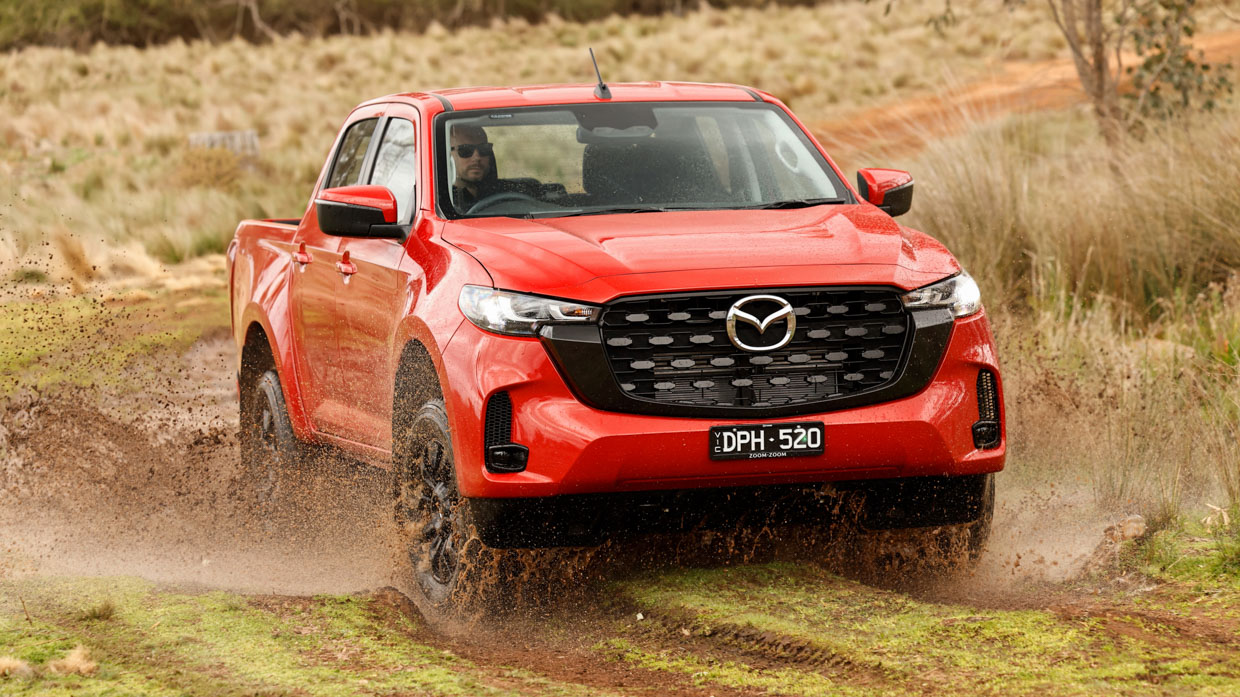
As the 4×4 system is unchanged — a traditional one with 2H, 4H and 4L modes activated via a rotary dial — the basic capability remains in the proven BT-50/D-Max platform.
You get a rear electronically activated differential lock, as well as the relatively-new Rough Terrain Mode which tightens up the traction control system when engaged to offer mountain-goat like abilities in technical terrain.
It’s a solid performer off-road from previous experience, and there’s no reason to suggest this has changed for 2025.
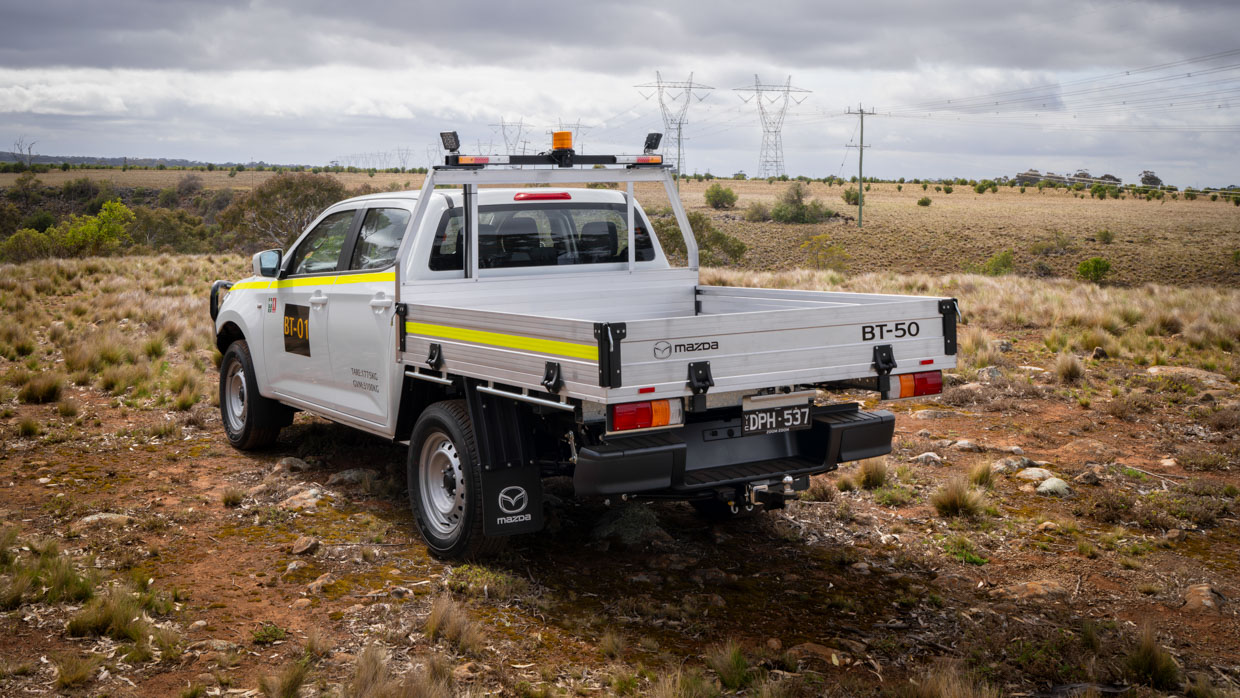
In summary, for an enthusiast that is going to tow or use the vehicle off-road, it’s best to nab a 3.0-litre BT-50 while it’s still here. It’s a rock-solid engine, with loads of further abilities in the aftermarket. You’ll also reap the benefits with a higher resale value when it’s time to sell.
If you need a fleet of 100 utes, and have been eyeing off the big ballroom at the Hilton for your work Christmas party, the 2.2L might just make that happen.



